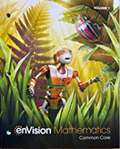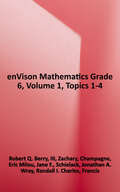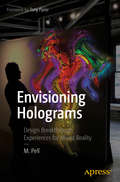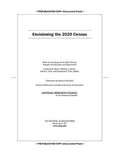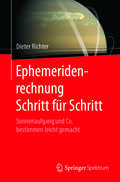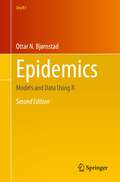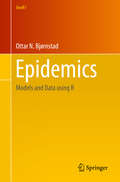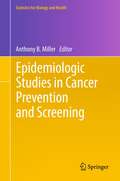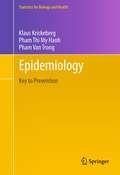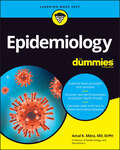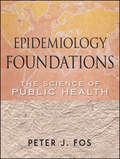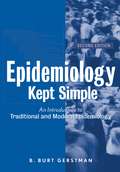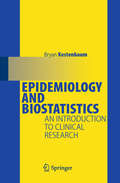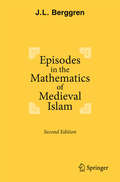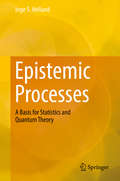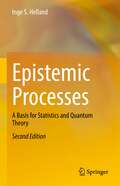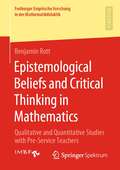- Table View
- List View
Envision Mathematics 2021 (Grade 6 Volume 1)
by Scott ForesmanEnvision Mathematics 2021 Common Core Student Edition Grade 6 Volume 1
Envision Mathematics 2021 National Additional Practice Grade 6
by Scott ForesmanEnvision Mathematics Grade 6 Additional Practice Workbook
Envision Mathematics 2021 National Student Edition Grade 6 Volume 2
by Randall I. Charles Jane F. Schielack Francis Fennell Robert Q. Berry Zachary Champagne Eric Milou Iii Jonathan A. WrayenVision Mathematics is grounded in problem-based and visual learning to create fun and engaging environments that invite inquiry and discovery. Hands-on problem-based activities to promote a deep understanding of concepts. Easy, flexible differentiation to ensure students' learning needs are met.
Envision Mathematics Grade 6, Volume 1, Topics 1-4
by Randall I. Charles Jane F. Schielack Francis Zachary Champagne Eric Milou Robert Q. Berry III Jonathan A. WrayenVision Mathematics is grounded in problem-based and visual learning to create fun and engaging environments that invite inquiry and discovery. Hands-on problem-based activities to promote a deep understanding of concepts. Easy, flexible differentiation to ensure students' learning needs are met.
Envision Mathematics: Additional Practice Workbook Grade 5
by Scott ForesmanYES! Now is the time to redefine your true self using Slader’s free Envision Mathematics 2020 Additional Practice Workbook Grade 5 answers. Shed the societal and cultural narratives holding you back and let free step-by-step Envision Mathematics 2020 Additional Practice Workbook Grade 5 textbook solutions reorient your old paradigms. NOW is the time to make today the first day of the rest of your life. Unlock your Envision Mathematics 2020 Additional Practice Workbook Grade 5 PDF (Profound Dynamic Fulfillment) today. YOU are the protagonist of your own life. Let Slader cultivate you that you are meant to be!
Envisioning Holograms: Design Breakthrough Experiences For Mixed Reality
by M. PellExplore the approach, techniques, and mindshift needed to design truly breakthrough experiences for the Microsoft HoloLens and Windows Mixed Reality platform. Learn what's so different about working with holograms, how to think spatially, and where to start designing your own holographic projects. You'll move rapidly from initial concept to persuasive prototype--all without the need for expensive tools or a designer's skill set. Designing for mixed reality is a completely new experience for everyone involved, and takes some experimentation to get right. You won't nail your first mixed reality project by relying upon your previous mobile or web design expertise as a guide. Mixed reality requires a different kind of design thinking for its unique challenges. Breakthrough holographic design starts with envisioning--the act of visualizing what could be. By rapidly depicting a desired experience and trying out its real-world interactions, you can quickly turn your initial vision into a tangible example of innovative design. Envisioning Holograms digs into why holographic computing is the future, takes you through the mixed reality design process, and gets you ready to take advantage of its endless opportunities.
Envisioning the 2020 Census
by National Research Council of the National AcademiesPlanning for the 2020 census is already beginning. This book from the National Research Council examines several aspects of census planning, including questionnaire design, address updating, non-response follow-up, coverage follow-up, de-duplication of housing units and residents, editing and imputation procedures, and several other census operations. This book recommends that the Census Bureau overhaul its approach to research and development. The report urges the Bureau to set cost and quality goals for the 2020 and future censuses, improving efficiency by taking advantage of new technologies.
Ephemeridenrechnung Schritt für Schritt: Sonnenaufgang und Co. bestimmen leicht gemacht
by Dieter RichterDas vorliegende Buch vermittelt die Grundkenntnisse der Ephemeridenrechnung. Ausgehend von den Kepler’schen Gesetzen erfolgt die Berechnung der Koordinaten der Planeten in der Bahnebene. Über eine Anzahl von Transformationen ermittelt man die Koordinaten im Horizontsystem und erhält damit die Winkel, die an einem Teleskop einzustellen sind, um einen bestimmten Planeten zu sehen. Dabei werden das Zweikörper- oder Kepler-Problem und die Berechnung weiterer Parameter, wie die Bahngeschwindigkeit und der Abstand der Planeten von der Sonne, geschlossen hergeleitet, ausführlich erklärt und am Beispiel einzelner Planeten vorgerechnet. Ergänzend dazu, und über das Zweikörperproblem hinausgehend, wird die Berechnung der Mondposition erläutert.Außerdem werden die wichtigsten Einflüsse auf die Planetenbahnen, die im Rahmen der Berechnung als Zweikörperproblem nicht berücksichtigt wurden, erklärt und deren Wirkung auf die Planeten abgeschätzt. Zum besseren Verständnis ist eine Reihe von Beispielen beschrieben und vorgerechnet, bei denen die erworbenen Kenntnisse angewendet werden.Das Buch wendet sich an Studierende der Naturwissenschaften, Physik, Astronomie und an Amateurastronomen sowie naturwissenschaftlich Interessierte, die schon immer einmal erfahren wollten, woher man denn weiß, wann die Sonne aufgeht..
Epidemics: Models and Data Using R (Use R!)
by Ottar N. BjørnstadThis book is designed to be a practical study in infectious disease dynamics. It offers an easy-to-follow implementation and analysis of mathematical epidemiology. It focuses on recent case studies in order to explore various conceptual, mathematical, and statistical issues. The dynamics of infectious diseases shows a wide diversity of pattern. Some have locally persistent chains-of-transmission, others persist spatially in consumer-resource metapopulations. Some infections are prevalent among the young, some among the old and some are age-invariant. Temporally, some diseases have little variation in prevalence, some have predictable seasonal shifts and others exhibit violent epidemics that may be regular or irregular in their timing.Models and ‘models-with-data’ have proved invaluable for understanding and predicting this diversity, and thence help improve intervention and control. Using mathematical models to understand infectious disease, dynamics has a very rich history in epidemiology. The field has seen broad expansions of theories as well as a surge in real-life application of mathematics to dynamics and control of infectious disease. The chapters of Epidemics: Models and Data Using R have been organized as follows: chapters 1-10 is a mix and match of models, data and statistics pertaining to local disease dynamics; chapters 11-13 pertains to spatial and spatiotemporal dynamics; chapter 14 highlights similarities between the dynamics of infectious disease and parasitoid-host dynamics; Finally, chapters 15 and 16 overview additional statistical methodology useful in studies of infectious disease dynamics.This book can be used as a guide for working with data, models and ‘models-and-data’ to understand epidemics and infectious disease dynamics in space and time. All the code and data sets are distributed in the epimdr2 R package to facilitate the hands-on philosophy of the text.
Epidemics: Models and Data using R (Use R!)
by Ottar N. BjørnstadThis book is designed to be a practical study in infectious disease dynamics. The book offers an easy to follow implementation and analysis of mathematical epidemiology. The book focuses on recent case studies in order to explore various conceptual, mathematical, and statistical issues. The dynamics of infectious diseases shows a wide diversity of pattern. Some have locally persistent chains-of-transmission, others persist spatially in ‘consumer-resource metapopulations’. Some infections are prevalent among the young, some among the old and some are age-invariant. Temporally, some diseases have little variation in prevalence, some have predictable seasonal shifts and others exhibit violent epidemics that may be regular or irregular in their timing. Models and ‘models-with-data’ have proved invaluable for understanding and predicting this diversity, and thence help improve intervention and control. Using mathematical models to understand infectious disease dynamics has a very rich history in epidemiology. The field has seen broad expansions of theories as well as a surge in real-life application of mathematics to dynamics and control of infectious disease. The chapters of Epidemics: Models and Data using R have been organized in a reasonably logical way: Chapters 1-10 is a mix and match of models, data and statistics pertaining to local disease dynamics; Chapters 11-13 pertains to spatial and spatiotemporal dynamics; Chapter 14 highlights similarities between the dynamics of infectious disease and parasitoid-host dynamics; Finally, Chapters 15 and 16 overview additional statistical methodology useful in studies of infectious disease dynamics. This book can be used as a guide for working with data, models and ‘models-and-data’ to understand epidemics and infectious disease dynamics in space and time.
Epidemiologic Research on Real-World Medical Data in Japan: Volume 1 (SpringerBriefs for Data Scientists and Innovators #1)
by Naoki NakashimaThis book analyzes the development of medical big data projects in Japan.Japan is experiencing unprecedented population aging, and labor productivity has decreased accordingly. Big data analysis of the Japanese medical real-world database (RWD) has the potential to tackle this issue.To allow readers to gain an understanding of Japanese medical big data analysis, the book discusses the original Japanese system that generates medical RWDs in the hospital medical records system, the nationwide standardized health checkup system, and the public medical insurance system in Japan.After introducing four major big data projects in the healthcare–medical field in Japan, the book explains the importance of creating information standards to maintain data quality and to analyze medical big data. It enables readers to analyze which standards are installed in which RWDs, how the standards are maintained, and which issues are prevalent in Japan.This book also describes the ethical processes involved in big data projects involving medical RWDs in Japan.
Epidemiologic Research on Real-World Medical Data in Japan: Volume 2 (SpringerBriefs for Data Scientists and Innovators #2)
by Naoki NakashimaThis book analyzes the development of medical big data projects in Japan.Japan is experiencing unprecedented population aging, and labor productivity has decreased accordingly. Big data analysis of the Japanese medical real-world database (RWD) has the potential to tackle this issue.To allow readers to gain an understanding of Japanese medical big data analysis, the book discusses the original Japanese system that generates medical RWDs in the hospital medical records system, the nationwide standardized health checkup system, and the public medical insurance system in Japan.After introducing four major big data projects in the healthcare–medical field in Japan, the book explains the importance of creating information standards to maintain data quality and to analyze medical big data. It enables readers to analyze which standards are installed in which RWDs, how the standards are maintained, and which issues are prevalent in Japan.This book also describes the ethical processes involved in big data projects involving medical RWDs in Japan.
Epidemiologic Studies in Cancer Prevention and Screening
by Anthony B. MillerEpidemiologic Studies in Cancer Prevention and Screening is the first comprehensive overview of the evidence base for both cancer prevention and screening. This book is directed to the many professionals in government, academia, public health and health care who need up to date information on the potential for reducing the impact of cancer, including physicians, nurses, epidemiologists, and research scientists. The main aim of the book is to provide a realistic appraisal of the evidence for both cancer prevention and cancer screening. In addition, the book provides an accounting of the extent programs based on available knowledge have impacted populations. It does this through: 1. Presentation of a rigorous and realistic evaluation of the evidence for population-based interventions in prevention of and screening for cancer, with particular relevance to those believed to be applicable now, or on the cusp of application 2. Evaluation of the relative contributions of prevention and screening 3. Discussion of how, within the health systems with which the authors are familiar, prevention and screening for cancer can be enhanced. Overview of the evidence base for cancer prevention and screening, as demonstrated in Epidemiologic Studies in Cancer Prevention and Screening, is critically important given current debates within the scientific community. Of the five components of cancer control, prevention, early detection (including screening) treatment, rehabilitation and palliative care, prevention is regarded as the most important. Yet the knowledge available to prevent many cancers is incomplete, and even if we know the main causal factors for a cancer, we often lack the understanding to put this knowledge into effect. Further, with the long natural history of most cancers, it could take many years to make an appreciable impact upon the incidence of the cancer. Because of these facts, many have come to believe that screening has the most potential for reduction of the burden of cancer. Yet, through trying to apply the knowledge gained on screening for cancer, the scientific community has recognized that screening can have major disadvantages and achieve little at substantial cost. This reduces the resources that are potentially available both for prevention and for treatment.
Epidemiology
by Klaus Krickeberg Thi My Pham Van Trong PhamThis book is meant for adoption in first courses on epidemiology in Medical Schools and Faculties of Public Health in developing and transition countries and in workshops in these countries, taught for example by members of international organizations. It is also suitable for parallel or second reading within curricula in developed countries and for teaching epidemiology in a Master's programme on "International Health". The book will enable any lecturer to compose his or her introductory courses on epidemiology by selecting the material deemed appropriate. It will provide a solid foundation for more advanced teaching. The intended readership consists in the first place of general medical students; students following the programme "Preventive Physician" that runs parallel to general medical studies in some countries; students starting to specialize in Public Health; and lecturers in epidemiology. The book can also serve well as an introduction into epidemiology for anybody else interested in this field, for example staff of health institutions. Examples and practical work are taken from the present situation of health in Vietnam, which can easily be adapted to any other developing or transition country.
Epidemiology For Dummies
by Amal K. MitraBecome a disease detective with this easy-to-understand resource Epidemiology For Dummies is packed with key concepts, practical applications, and real-life examples in the study of disease transmission and control. It's a must-have for students in all public-health-related fields, and for curious learners, too. This Dummies guide will help you conquer even the trickiest epidemiological concepts. In this introduction to the fascinating, complex science, you’ll learn—in terms anyone can understand—all the basic principles of epidemiology, plus how those concepts translate to public health outcomes and policy decisions. Learn the basic principles and concepts of epidemiology Discover real-world examples and public health threats Understand the complex social factors that influence health Embark on a public health career or just pass your epidemiology courseAnyone who wants or needs to understand the fundamentals of epidemiology and the science behind public health will love Epidemiology For Dummies.
Epidemiology Foundations
by Peter J. FosWritten by Peter J. Fos-an expert in epidemiology with more than twenty years teaching experience-Epidemiology Foundations offers an ideal introduction to the theory and practice of public health epidemiology. This important text discusses both the historical perspective and future trends of epidemiology, reviews health and disease, and explains how they are measured. The book's overview of epidemiological studies shows how they are used in practice. Epidemiology Foundations takes a social and community perspective and includes information about global diseases and epidemics. Emphasis on concepts such as population health, social determinants, and global health make this book especially interesting and accessible to those new to the subject. Each chapter is supplemented with problem-solving exercises and research assignments to aid readers in understanding its epidemiology principles. Reflecting and expanding on recommendations of the Association of American Colleges and Universities, Epidemiology Foundations is the ideal text for any course introducing epidemiology in public health.
Epidemiology Kept Simple
by B. Burt GerstmanEpidemiology Kept Simple introduces the epidemiological principles and methods that are increasingly important in the practice of medicine and public health. With minimum use of technical language it fully explains terminology, concepts, and techniques associated with traditional and modern epidemiology. Topics include disease causality, epidemiologic measures, descriptive epidemiology, study design, clinical and primary prevention trials, observational cohort studies, case-control studies, and the consideration of random and systematic error in studies of causal factors. Chapters on the infectious disease process, outbreak investigation, and screening for disease are also included. The latter chapters introduce more advanced biostatistical and epidemiologic techniques, such as survival analysis, Mantel-Haenszel techniques, and tests for interaction.This third edition addresses all the requirements of the American Schools of Public Health (ASPH) Epidemiological Competencies, and provides enhanced clarity andreadability on this difficult subject. Updated with new practical exercises, case studies and real world examples, this title helps you develop the necessary tools to interpret epidemiological data and prepare for board exams, and now also includes review questions at the end of each chapter.Epidemiology Kept Simple continues to provide an introductory guide to the use of epidemiological methods for graduate and undergraduate students studying public health, health education and nursing, and for all practicing health professionals seeking professional development.
Epidemiology and Biostatistics
by Bryan KestenbaumConcise, fast-paced, intensive introduction to clinical research design for students and clinical research professionals Readers will gain sufficient knowledge to pass the United States Medical Licensing Examination part I section in Epidemiology
Epidemiology: Key to Public Health (Statistics for Biology and Health)
by Klaus Krickeberg Pham Van Trong Pham Thi My HanhThis unique textbook presents the field of modern epidemiology as a whole; it does not restrict itself to particular aspects. It stresses the fundamental ideas and their role in any situation of epidemiologic practice. Its structure is largely determined by didactic viewpoints.Epidemiology is the art of defining and investigating the influence of factors on the health of populations. Hence the book starts by sketching the role of epidemiology in public health. It then treats the epidemiology of many particular diseases; mathematical modelling of epidemics and immunity; health information systems; statistical methods and sample surveys; clinical epidemiology including clinical trials; nutritional, environmental, social, and genetic epidemiology; and the habitual tools of epidemiologic studies. The book also reexamines the basic difference between the epidemiology of infectious diseases and that of non-infectious ones.The organization of the topics by didactic aspects makes the book ideal for teaching. All examples and case studies are situated in a single country, namely Vietnam; this provides a particularly vivid picture of the role of epidemiology in shaping the health of a population. It can easily be adapted to other developing or transitioning countries.This volume is well suited for courses on epidemiology and public health at the upper undergraduate and graduate levels, while its specific examples make it appropriate for those who teach these fields in developing or emerging countries. New to this edition, in addition to minor revisions of almost all chapters:• Updated data about infectious and non-infectious diseases• An expanded discussion of genetic epidemiology• A new chapter, based on recent research of the authors, on how to build a coherent system of Public Health by using the insights provided by this volume.
Epidemiology: Principles and Practical Guidelines
by Jonathan R Brestoff Jan Van den BroeckThis textbook presents epidemiology in a practical manner, contextualized with discussions of theory and ethics, so that students and professionals from all academic backgrounds may develop a deep appreciation for how to conduct and interpret epidemiological research. Readers will develop skills to: -Search for and appraise literature critically, -Develop important research questions, -Design and implement studies to address those questions, -Perform and interpret fundamental statistical estimations and tests, -Consider the ethical implications of all stages of research, -Report findings in publications, and -Advocate for change in the public health setting. Epidemiology is and will remain a discipline in motion, and this textbook aims at reflecting this dynamism and keeping pace with its momentum. This textbook is not only a classroom tool with high utility but also an essential reference and guide for those engaging in research involving human subjects.
Epidemiology: Study Design and Data Analysis, Third Edition (Chapman & Hall/CRC Texts in Statistical Science)
by Mark WoodwardHighly praised for its broad, practical coverage, the second edition of this popular text incorporated the major statistical models and issues relevant to epidemiological studies. Epidemiology: Study Design and Data Analysis, Third Edition continues to focus on the quantitative aspects of epidemiological research. Updated and expanded, this edition shows students how statistical principles and techniques can help solve epidemiological problems.New to the Third Edition New chapter on risk scores and clinical decision rules New chapter on computer-intensive methods, including the bootstrap, permutation tests, and missing value imputation New sections on binomial regression models, competing risk, information criteria, propensity scoring, and splines Many more exercises and examples using both Stata and SAS More than 60 new figures After introducing study design and reviewing all the standard methods, this self-contained book takes students through analytical methods for both general and specific epidemiological study designs, including cohort, case-control, and intervention studies. In addition to classical methods, it now covers modern methods that exploit the enormous power of contemporary computers. The book also addresses the problem of determining the appropriate size for a study, discusses statistical modeling in epidemiology, covers methods for comparing and summarizing the evidence from several studies, and explains how to use statistical models in risk forecasting and assessing new biomarkers. The author illustrates the techniques with numerous real-world examples and interprets results in a practical way. He also includes an extensive list of references for further reading along with exercises to reinforce understanding. Web ResourceA wealth of supporting material can be downloaded from the book’s CRC Press web page, including: Real-life data sets used in the text SAS and Stata programs used for examples in the text SAS and Stata programs for special techniques covered Sample size spreadsheet
Episodes in the Mathematics of Medieval Islam
by J. L. BerggrenThis book presents an account of selected topics from key mathematical works of medieval Islam, based on the Arabic texts themselves. Many of these works had a great influence on mathematics in Western Europe. Topics covered in the first edition include arithmetic, algebra, geometry, trigonometry, and numerical approximation; this second edition adds number theory and combinatorics. Additionally, the author has included selections from the western regions of medieval Islam--both North Africa and Spain. The author puts the works into their historical context and includes numerous examples of how mathematics interacted with Islamic society.
Epistemic Processes: A Basis for Statistics and Quantum Theory
by Inge S. HellandThis book discusses a link between statistical theory and quantum theory based on the concept of epistemic processes – which can be e.g. statistical investigations or quantum mechanical measurements, and refer to processes that are used to gain knowledge about something. The book addresses a range of topics, including a derivation of the Born formula from reasonable assumptions, a derivation of the Schrödinger equation in the one-dimensional case, and a discussion of the Bell inequality from an epistemic perspective. The book describes a possible epistemic foundation of quantum theory. Lastly, it presents a general philosophical discussion of the approach, which, principally speaking, is not restricted to the micro-world. Hence the book can also be seen as a motivation for further research into quantum decision theory and quantum models for cognition. The book will benefit a broad readership, including physicists and statisticians interested in the foundation of their disciplines, philosophers of science and graduate students, and anyone with a reasonably good background in mathematics and an open mind.
Epistemic Processes: A Basis for Statistics and Quantum Theory
by Inge S. HellandThis book discusses a link between statistical theory and quantum theory based on the concept of epistemic processes. The latter are processes, such as statistical investigations or quantum mechanical measurements, that can be used to obtain knowledge about something. Various topics in quantum theory are addressed, including the construction of a Hilbert space from reasonable assumptions and an interpretation of quantum states. Separate derivations of the Born formula and the one-dimensional Schrödinger equation are given. In concrete terms, a Hilbert space can be constructed under some technical assumptions associated with situations where there are two conceptual variables that can be seen as maximally accessible. Then to every accessible conceptual variable there corresponds an operator on this Hilbert space, and if the variables take a finite number of values, the eigenspaces/eigenvectors of these operators correspond to specific questions in nature together with sharp answers to these questions. This paves a new way to the foundations of quantum theory. The resulting interpretation of quantum mechanics is related to Hervé Zwirn's recent Convivial Solipsism, but it also has some relations to Quantum Bayesianism and to Rovelli's relational quantum mechanics. Niels Bohr's concept of complementarity plays an important role. Philosophical implications of this approach to quantum theory are discussed, including consequences for macroscopic settings.The book will benefit a broad readership, including physicists and statisticians interested in the foundations of their disciplines, philosophers of science and graduate students, and anyone with a reasonably good background in mathematics and an open mind.
Epistemological Beliefs and Critical Thinking in Mathematics: Qualitative and Quantitative Studies with Pre-Service Teachers (Freiburger Empirische Forschung in der Mathematikdidaktik)
by Benjamin RottEpistemological beliefs—i.e. beliefs on the nature of knowledge, its limits, sources, and justification—play an important role both in everyday life and in learning processes. This book comprises several studies dealing with such beliefs in the domain of mathematics; amongst others a qualitative interview study, and quantitative studies for which a new questionnaire has been developed. In this new instrument, belief position (e.g. “mathematical knowledge is certain” vs. “uncertain”) and belief argumentation (the way those positions are justified) are differentiated. Additionally, a test for mathematical critical thinking has been designed.The results show significant correlations between sophisticated belief argumentations and high scores in the critical thinking test, but no correlations regarding belief positions.
